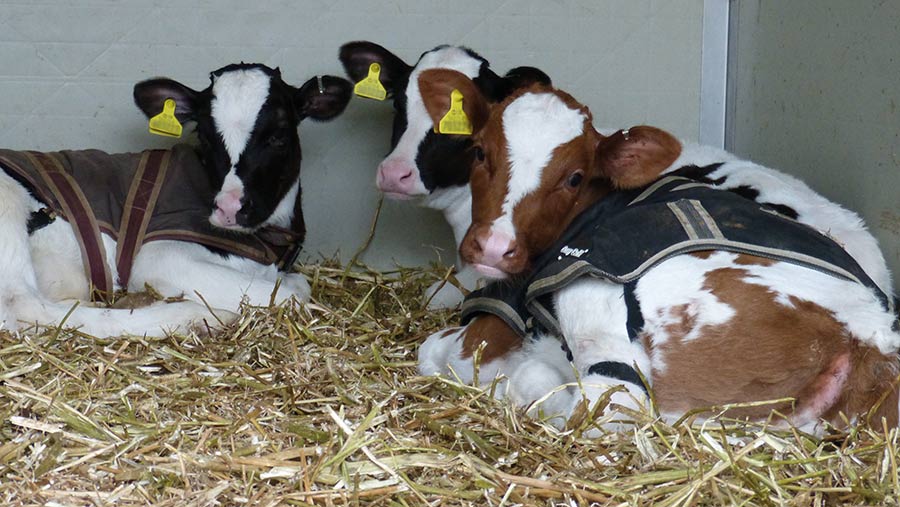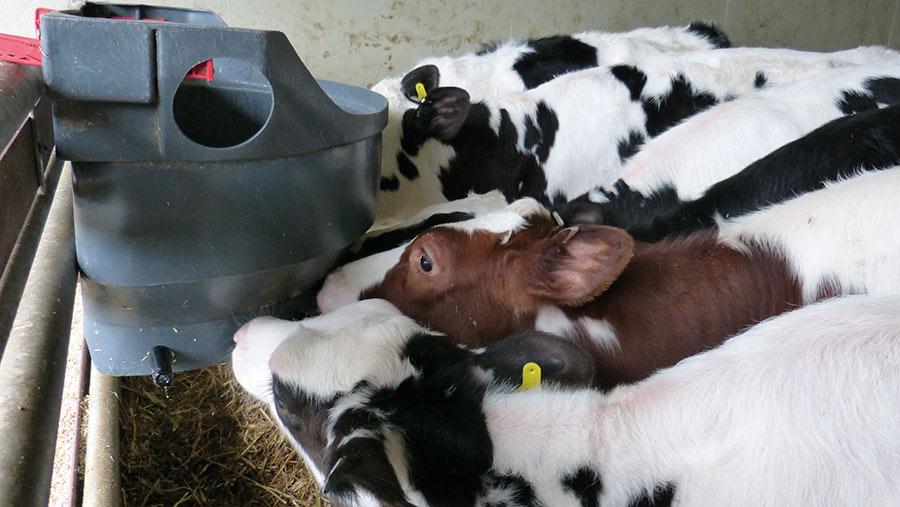How Devon dairy lifted calf growth rates by 50%
 © Michael Priestley
© Michael Priestley Investing in calf housing and milk powder is paying dividends for a North Devon dairy farm, which has seen mortality and drug use fall and growth rates lift.
The longer-term impacts of healthier, faster-growing calves entering the dairy herd are still to be seen at High Park Farm, Bideford, but the early signs are promising.
This is according to father and son team Andrew and Peter Hockridge, who rear their own replacements for their 250-head Holstein autumn calving herd.
See also: How a bespoke calf barn cut antibiotic use and mortality
Farm facts: High Park
- Yields 9,500 litres at 4.3% butter fat and 3.4% protein
- Achieves 3,995 litres from forage
- 182ha (449 acres) of which 80ha (197 acres) owned
- Approximately 60ha (148 acres) of maize grown last year, of which 20ha (49 acres) was sold
- Grows 12ha (30 acres) wheat and 20ha (49 acres) of Lucerne
- Grazes youngstock and dry cows through the summer
- 0.32kg/litre feed rate
- Supplying Arla on a manufacturing contract
Challenges to tackle
The High Park herd calves from June to November, which historically meant a flurry of calves in late November and December when room became tight.
All dairy heifer calves are reared at home and beef-cross calves are sold at six-to-eight weeks old at Holsworthy market.
The increase in calves during those two months has typically resulted in pathogens building up in sheds and a spike in calf mortality around Christmas time when numbers of calves on milk peaked at about 60 head.
In December 2018, a mycoplasma outbreak killed 13 calves, something the Hockridges don’t want to see happen again.
The previous system saw calves penned individually in hurdles for 10-14 days before being grouped for the remaining eight-to-nine weeks of the milk feeding phase.
The grouped stage was spent in a roomy steel-framed cattle building with a clay floor, pitched roof, dung boards around the outside of the shed (1.8m high) and wood boarding above.
New system
Calves are still penned individually in the nursery shed, but most are now moved into a specific calf house with calves of a similar age, in groups of six to seven.
Meanwhile, the new shed frees up more room inside for the other calves, explains Peter.
A row of eight optimum climate calf barns (OCCB) houses the calves from 2-12 weeks of age (see “Optimum climate calf barns” box).
The north-east facing barns sit 50m away from any other sheds in a sheltered part of the farm. This means the prevailing wind blows across the sheds but rarely into them.
As well as changing the building, the Hockridges also changed their milk powder, opting for a 60% skimmed milk powder, which uses 100% dairy protein, from Three Counties Feeds.
Milk powder
- 25% crude protein, 21% fat, 5% ash and 0.005% fibre
- 100% dairy protein
- 40% coconut oil
- Contains vitamins A and E
Calf nutrition
Calves are fed six litres of milk (900g of powder a calf a day) in two feeds from a milk train pulled by a quad bike.
Calves have access to ground rape straw and a 20% protein nut, with whole maize and cooked barley to help rumen development. Calves are usually eating 2.5kg a head a day by seven weeks of age.
Calves are weaned over five days at 12 weeks old, with milk reduced from six litres/day to nothing. They remain in the pen for at least another week until being moved to the grower shed.

© Michael Priestley
Comparing performance
Vet Emily Linton of Torch Farm Vets recorded and compared pre-weaning performance in the old and new system.
Torch Farm Vets also recently purchased thermometer and humidity monitors, which they installed in both buildings to compare fluctuations.
Despite last winter being very wet and challenging, the study found the average weight gain in the new calf unit was 56% more (see table below).
Improvements in calf performance |
|||
|
Trait |
June-February 2018-19 |
June-February 2019-20 |
Difference |
|
Average daily liveweight gain |
0.48kg |
0.75kg |
0.27kg |
|
Pneumonia drug spend |
£1,388 |
£822 |
£566 (41% reduction) |
|
Mortality |
21 calves (8%) 2 scour related The rest were attributable to mycoplasma/pneumonia |
5 calves (2%) All scour related and in calves that hadn’t reached the new barns |
16 calves |
|
Temperature variation (outside temperatures reached 1C) |
1-14C 13C variation |
5-14C 9C variation |
Reduced temperature variation lowers challenge put on calves |
|
Humidity variation |
65-97% |
70-91% |
Reduced humidity variation is better for respiratory health and inhibiting pathogens |
Cost and payback
Despite the milk powder being expensive (£2,000/t), Peter has calculated that each feed is 10p cheaper than feeding whole milk (at a milk price of 31p/litre).
The calf units cost £3,250, but the improvements in mortality more than paid for one unit in a year. At a rough value of £250 for a weaned calf, the 16 extra calves weaned are worth £4,000, explains Peter.
Calves growing faster and having fewer problems could dramatically help the farm’s cost structure in the future.
Currently, the farm calves down at about 26 months, but with heifers growing faster, Andrew and Peter are looking at calving at 25 months, which would save on feeding growing heifers.
Future
The Hockridges are now considering buying another eight-bay OCCB to house dairy-cross beef calves.
Peter adds: “With us switching to sexed semen, we can produce more beef-cross calves.
“We are considering rearing these and selling weaned calves into the Buitelaar supply chain.”
Optimum climate calf barns
The optimum climate calf barn was developed in Germany and has been used across northern Europe for 10 years.
It is a propylene plastic structure that completely segregates each pen of calves from each other to allow the easy cleaning of individual units in isolation and to contain any disease to one bay.
The suppliers claim that a low-angled roof uses the stack effect from the calves to drive stale air out of the units.
- Inside dimensions: 6m x 3m – 2.4m high at the front and 1.96m high at the rear
- Outside dimensions: 6m roof panel, 53mm wall thickness
- Features: Galvanised front with entrance door for staff, automatic drinker, 10-teat milk bar, partition for milk bar and feeding trough, comes with a 10-year guarantee
- Positioning advice: Away from prevalent wind, 2-5% angle slope (1.15-2.86deg from back to front) for drainage, pitch on concrete
- Cost: One unit = £3,500. Two or more units = £3,250 each (ex VAT, including delivery). Erection cost is £200 from The Calf Company
